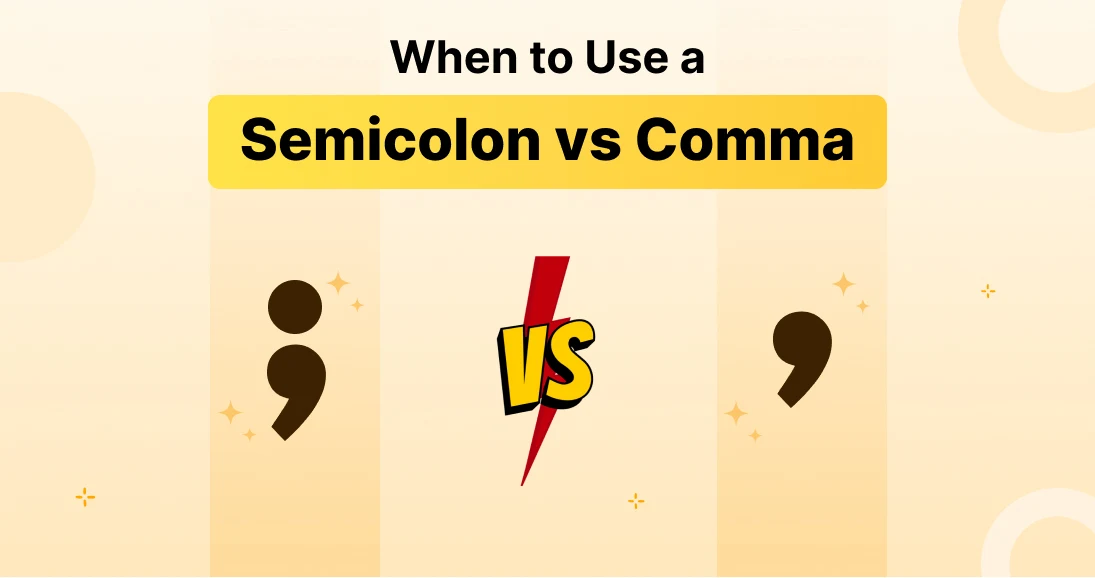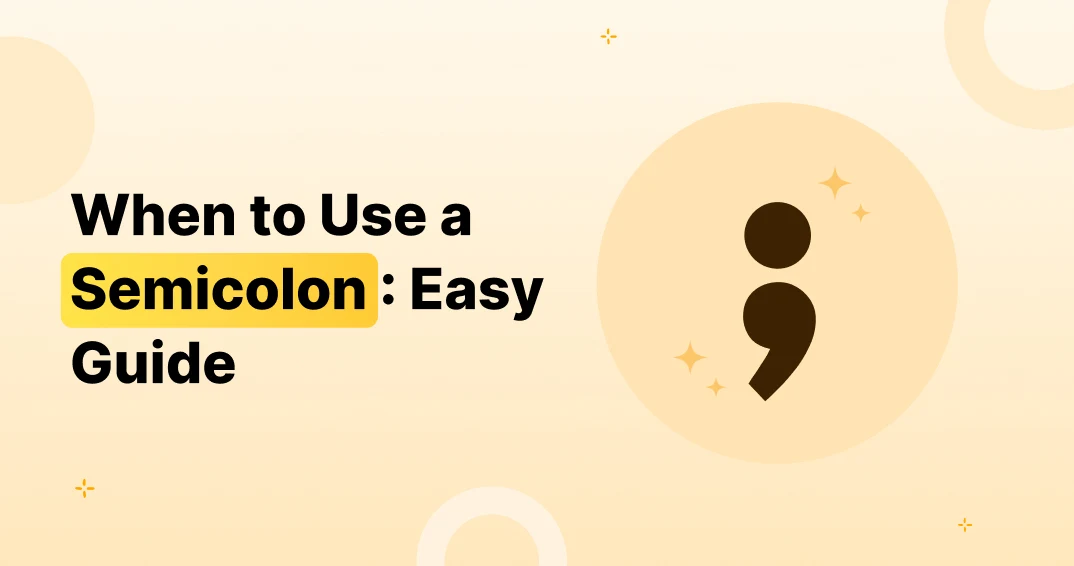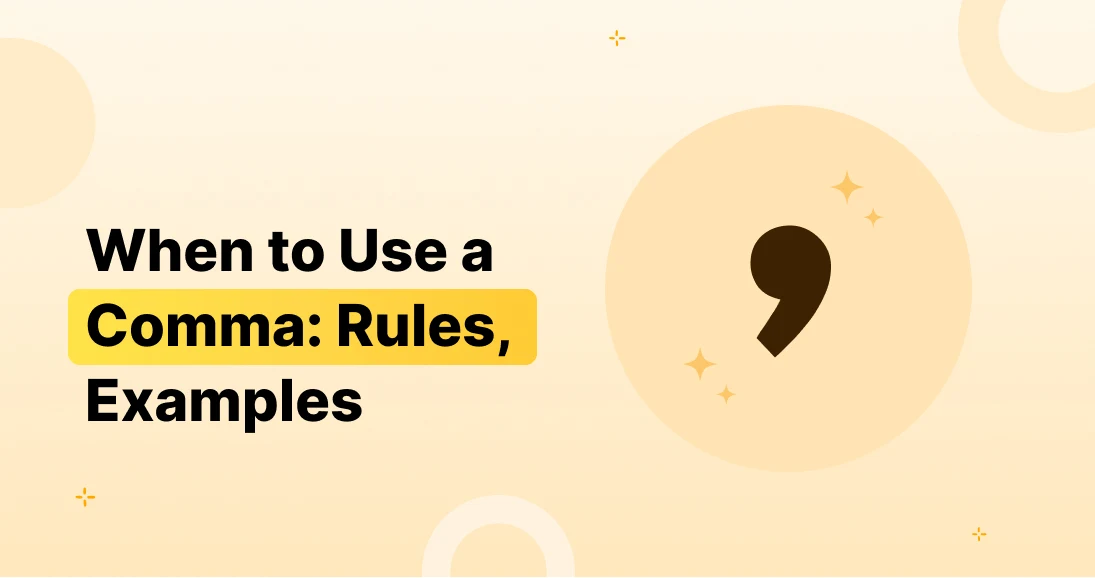Punctuation could make or spoil your message. Misplace a comma or drop in a semicolon in which it doesn’t belong, and your sentence sounds complicated—or worse, absolutely modifications which means. That’s why understanding whilst applying a semicolon vs comma is greater than only a grammar flex—it’s a must-have writing skill.
Whether you are crafting emails, writing essays, or publishing expert content material, those punctuation marks assist structure your mind really. But maximum people battle to recognize where the line is drawn among the two.
Key Takeaways:
- Learn the clear difference between a comma and a semicolon
- See real-world examples and side-by-side comparisons
- Master rules for using punctuation in lists, clauses, and transitions
- Avoid common grammar mistakes that weaken your writing
- Discover how punctuation clarity improves professional communication
What Is a Comma?
A comma (,) is one of the most used punctuation marks in English. It shows a brief pause in a sentence, separating elements to enhance clarity and flow.
Common Uses of a Comma
- To separate items in a list
Example: I packed socks, a charger, a notebook, and snacks. - Before a coordinating conjunction in compound sentences
Example: She wanted to stay, but he had to leave. - After introductory words or phrases
Example: After the meeting, we went for lunch.
If you’re thinking about comma and semicolon policies, a quick tip is this: if the element after the punctuation isn’t a complete sentence, you’re probably using a comma efficiently.
What Is a Semicolon?
A semicolon (;) connects carefully related independent clauses—that is, entire sentences that might stand by themselves, however paintings are higher whilst tied collectively. It’s stronger than a comma, but not as very last as a length.
Primary Uses of a Semicolon
- Linking independent clauses without a conjunction
Example: The project was delayed; the team lacked key data. - Separating items in a complex list that already contains commas
Example: We traveled to Austin, Texas; Denver, Colorado; and Phoenix, Arizona.
This is where semicolon use truly shines: when your sentence already has commas and needs clearer separation between parts.
When to Use a Semicolon vs Comma
Here’s the golden rule: use a semicolon when you’re connecting complete thoughts. Use a comma when you’re adding information to one thought or dividing elements that aren’t fully independent.
Quick Comparison Table
| Use Case | Use a Comma | Use a Semicolon |
| Joining with “and,” “but,” etc. | ✅ Yes | 🚫 Not required |
| Without conjunction | 🚫 Too weak | ✅ Strong and correct |
| Items in a simple list | ✅ Yes | 🚫 Unnecessary |
| Items in a complex list | 🚫 Might confuse | ✅ Adds clarity |
Knowing the difference between a comma and semicolon helps you write with precision, especially in formal and professional settings.
When to Use a Semicolon Instead of a Comma
Many writers confuse these punctuation marks in compound sentences. If you use a comma between two full sentences without a coordinating conjunction (like and, but, or), it’s called a comma splice—a common grammar error.
Example of Incorrect Use
❌ He studied all night, he still failed the test.
Corrected with a Semicolon
✅ He studied all night; he still failed the test.
Understanding when to use a semicolon instead of a comma helps you eliminate this mistake and write more confidently.
Semicolons also support smoother transitions with conjunctive adverbs like however, therefore, and for example—a style often seen in academic and business writing.
Use of Semicolon vs Comma in Complex Sentences
Some lists are too cluttered for commas alone. If you’re writing a list where each item contains commas, semicolon comma rules recommend switching to semicolons for clarity.
Example:
We invited Rachel, my project manager; Kevin, the CEO; and Lily, our design lead.
This is a classic example of use of semicolon vs comma logic: when internal commas already exist, semicolons step in to simplify readability.
Real-Life Examples of Proper Usage
Seeing punctuation in action is the easiest way to internalize the rules. Below are real-life comparisons to help you make smarter choices between semicolons and commas.
✦ Example 1: Two Independent Clauses
Incorrect:
The office was silent, the meeting had ended.
Correct:
The office was silent; the meeting had ended.
✅ Use a semicolon when joining two complete thoughts without a conjunction.
✦ Example 2: Complex List
Incorrect:
The tour included stops in Paris, France, Rome, Italy, and Berlin, Germany.
Correct:
The tour included stops in Paris, France; Rome, Italy; and Berlin, Germany.
✅ Use semicolons to clarify long lists that contain commas within items.
Common Errors with Commas and Semicolons
Even experienced writers fall into traps when using punctuation. Let’s spotlight some major missteps.
1. The Comma Splice
Using a comma to join two full sentences is incorrect unless you add a conjunction.
❌ She was tired, she kept working.
✅ She was tired, but she kept working.
✅ She was tired; she kept working.
2. Overusing Semicolons
Semicolons are not meant to replace every comma or period. They should only be used when two complete thoughts are directly related.
❌ I love chocolate; especially dark chocolate.
✅ I love chocolate, especially dark chocolate.
Colon vs Semicolon: What’s the Difference?
People often confuse colons and semicolons—but they serve different functions.
Use a Colon When…
- Introducing a list or explanation
Example: She brought three things: a pen, a notebook, and her phone. - Emphasizing a conclusion
Example: There was only one answer: run.
Use a Semicolon When…
- Linking two independent but related thoughts
Example: He didn’t study; the results reflected it.
Remember, a colon points forward to more detail, while a semicolon balances two complete thoughts.
Advanced Tips: Mastering Comma and Semicolon Rules
Once you know the basics, elevate your writing with these advanced punctuation tips:
- When using transition phrases (e.g., however, therefore), precede them with a semicolon and follow them with a comma.
Example: She agreed to help; however, she needed more time. - Don’t confuse semicolon vs comma examples with their usage in dialogue or quotations. This is especially important in academic writing. If you’re also exploring rules on direct speech, punctuation, and quoting others, you might want to check out a guide like How to Use Quotation Marks to complete your grammar toolkit.
Text Shortcuts and Clarity in Digital Writing
Nowadays’s fast-moving international virtual communiqué, expertise in punctuation is extra than grammar—it’s a part of the iOS Text Shortcuts lifestyle. Whether writing weblog posts, newsletters, or social media updates, accurate punctuation facilitates keeping away from misunderstandings.
Misused commas or semicolons can change the entire tone of a message. That’s why clean punctuation is essential in both casual texts and professional content.
Rise of AI Powered Keyboard and Writing Assistance
With the Rise of AI Powered Keyboard apps, writers and content creators now receive instant grammar and punctuation suggestions. These tools help determine when to use a semicolon instead of a comma—a task that once required a deep knowledge of language rules.
Pair this with the Using AI Chat Feature, and you’ve got real-time answers to punctuation questions, sentence flow issues, and grammar confusions without opening a browser or flipping through grammar books.
Final Thoughts: Know When to Use a Semicolon vs Comma
Understanding whilst to use a semicolon vs comma is ready extra than memorizing rules—it’s approximately writing with self-assurance and readability.
Here’s a quick recap:
- Use commas to separate ideas within a sentence
- Use semicolons to connect complete but related ideas
- Watch for complex lists and comma splices
- Recognize when to apply colons instead of semicolons
- Combine this knowledge with text shortcuts and AI tools for modern writing success
The more you practice, the more naturally punctuation will flow in your writing. And with the help of intelligent tools, you’re never far from perfect phrasing.








